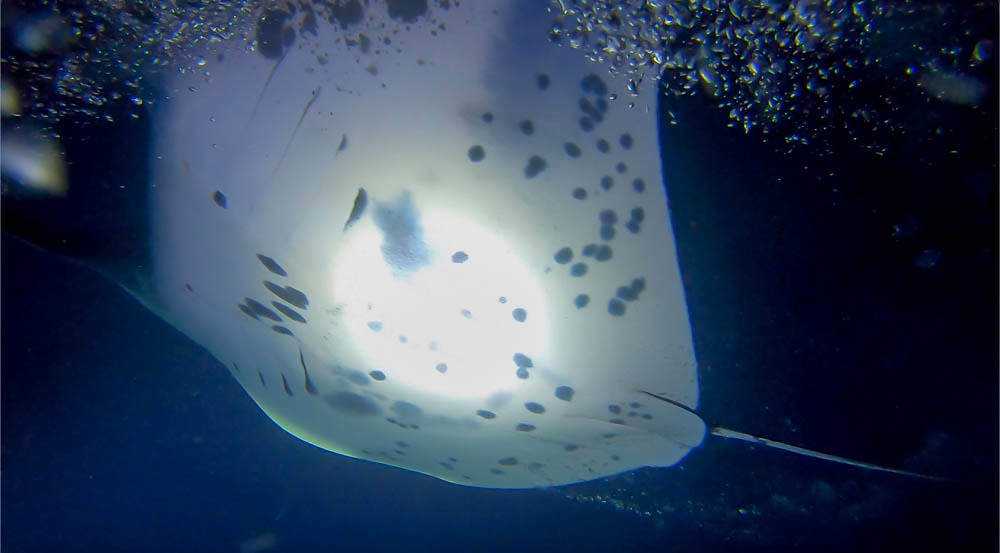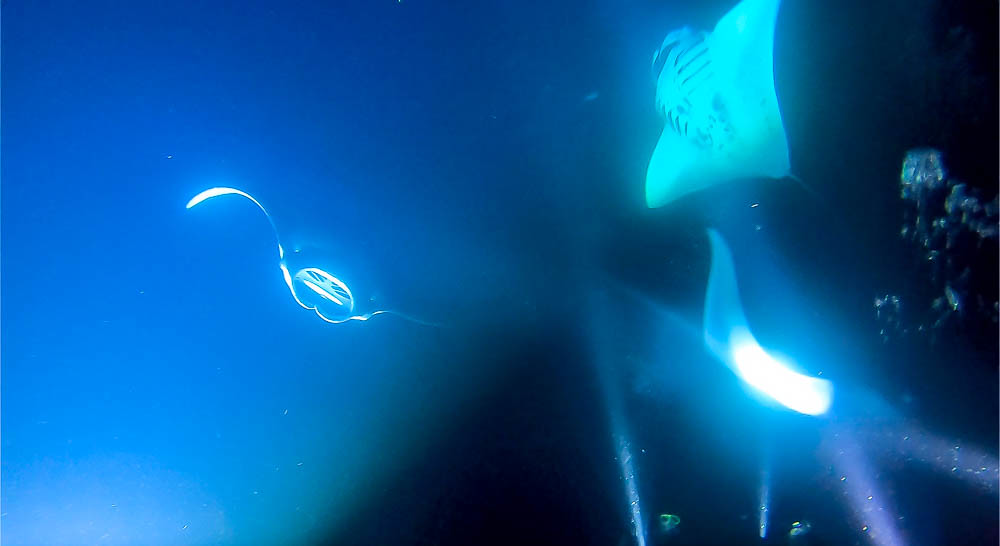Big Island manta ray tour operators mixed about proposed rules, possible new law
The manta ray night dive off the coast of Kona is on the bucket list of many divers from around the world. It is a unique experience for snorkelers, too.
Tour operators bring bright lights, which attract plankton, a yummy meal for the manta rays. To gobble up the plankton, the majestic black and white sea creatures — with distinctive markings and wing spans of about 12 feet — swoop through the water with their mouths open. It looks like a choreographed dance, watching them gracefully swim through the water, turning and somersaulting, often within a few feet of divers. For many, it’s mesmerizing and magical.
It’s also popular. Dive Magazine said Kona is one of the 12 best places in the world to dive with manta rays, along with Indonesia, Micronesia and the Maldives.
But for more than a decade, with more and more manta ray tour companies converging at two small viewing areas off the West Hawai’i coast, ocean advocates and some tour operators have been concerned about safety and the preservation of the marine resource.
Calls for state regulation led to the Hawai’i State Department of Land and Natural Resources proposing manta ray viewing rules in 2015, after voluntary safety standards created in 2012 by the U.S. Coast Guard and commercial dive operators did not solve the problems.
But the proposed rules went nowhere. The state Division of Boating and Recreation said the reason was a run on commercial use permits during the rule-making process. Those slew of permit applications could not be denied before the limits of operators could be finalized.
Now, the state is trying again, with new proposed manta ray viewing rules that limit tours to 24 commercial boats. But this time, there is legislation in the works — the State Legislature-passed House Bill 1090 — which if it becomes law would enable the state to enforce those commercial boat limits. The law allows the state, when limits are met, to not renew permits based on seniority and other factors.
Now, the only way the number of permits for manta ray viewing can drop is through attrition, meaning when existing permits are not renewed, new ones are not issued.
“The issue with attrition is that the vast majority of businesses are incorporated so the business is usually sold and the permits transfer with the business so attrition is basically non-existent,” the state boating division said.
Martina Wing, who has a blog Manta Ray Advocates, said the death last year of a crew member on a manta ray tour renewed the call that something had to be done to regulate the operators.
“These proposed regulations for manta ray tourism in Hawai’i are much needed to protect both manta rays and humans involved,” Wing said.
Currently, the Division of Boating and Ocean Recreation estimates there are about 60 to 70 boats a day that visit the Ocean Recreation Management Areas of Makako Bay (Garden Eel Cove) near Honokohau Harbor and Kaukalaelae Point (Keauhou Bay).
In October 2022, the Board of Land and Natural Resources initiated new proposed manta ray viewing rules that would limit tours to 24 commercial boats, bringing a total of 60 passengers to each site per day. Manta ray viewing hours also would be limited from 4 p.m. until 4 a.m., with a two-hour limit and requiring one guide for every eight customers.

Safety requirements would include specific vessel lighting, propeller guards or safety lookout. Wing’s blog points out the dangers to manta rays and divers/snorkelers.
A public hearing was held on the proposed rules in February, but there are several more steps that need to be taken before the new rules can be adopted. But those next steps have been put on hold to see what happens with House Bill 1090.
“A lot depends on what the governor decides to do,” said Ryan Aguilar, a spokesperson with the Department of Land and Natural Resources.
The bill now is on Gov. Josh Green’s desk, and it is not clear whether he will sign it. There is concerns by many commercial boat owners and water recreation companies around the state that if the bill becomes law it could put them out of business.
The measure mandates how ocean recreation commercial permits that operate at an ocean recreation management area or state boating facility will be doled out or renewed. There will be companies who now have permits that will not get them renewed.
If it becomes law, it would not only impact manta ray tours, but also sightseeing boat tours, surf schools, kayaking companies, commercial recreational fishing boats, and scuba and snorkeling companies at harbors and launch ramps throughout the state.
Tom Young is one of the concerned business owners. He operates tour companies Hawai’i Oceanic and Coral Reef Snorkel Adventures, which run out of Keauhou Bay and Honokohau Harbor. He said his businesses would be in jeopardy if the manta ray viewing limits are adopted and the bill becomes law.

He would be low on the seniority totem pole, having just bought his companies in 2021 after moving to Hawaiʻi the previous year with his wife and daughters. He had previously worked in the tech industry and ran an advertising agency in Silicon Valley. Young said Coral Reef Snorkel Adventures originally started in 2003 and Hawai’i Oceanic in 2013 and seniority will be based on those dates.
Young said he is willing to scale back his tour operations.
“I rely on this income to feed my family, so it’s a pretty big threat,” he said.
Some manta ray tour operators say even if the rules are adopted and the bill becomes law, they wonʻt address all of the problems.
Manu Powers, co-owner of snorkeling tour company Sea Quest Hawaiʻi, is not worried about seniority. Sea Quest has been in business since 1988. Powers, the president of the Daughters of Hawai’i, an organization that is a cultural advisor to Kamehameha Schools, is passionate about preserving the Big Island for future generations.
Keauhou Bay is located at the end of Kamehameha III Road, aptly named as the site of the birthplace of King Kamehameha III. This bay was a favorite retreat for Hawaiian royalty, and today, the area celebrates its history with several historic sites and a carefully restored heiau (temple).
Powers agrees something should be done to stop the overcrowding of the manta rays, but HB 1090 isn’t it. She said she has been trying to get the Department of Land and Natural Resources to work with the tour operators about the issue.
“We aren’t opposed to regulation,” she said. “What we want is smart regulation that is enforceable and practicable. You have to work with the operators and you have to have conversations. You have to be here and really understand how it works.”
She said the issues impacting Keauhou Bay are multifaceted.
Some companies drop guests in the channel, leaving guides and guests in the water while they go to back to shore to get more people.
Other companies, she said, do not have boat crews who are CPR and lifeguard certified, donʻt hire captains with clean records, and donʻt educate staff and others about how to minimize impact on the manta rays.
She also is concerned that some tour operators travel from the Honokohau Harbor to Keauhou when there are no manta rays up north, leading to more overcrowding around the marine creatures.

She said on a normal night there are only 8 to 12 boats operating out of Keauhou, but if there are no manta rays near Honokohau Harbor, about 20 to 25 boats can be out there at once.
“Our ratio is 4.5 guests to one guide. There are companies out there that operate 20 guests to one guide,” she said.
She said the state should start by mandating that a permit is only good for one site, either Keauhou or Honokohau. That would limit the number of boats at each site.
Green has until July 11, 2023, to sign HB 1090 or deliver the veto. If the governor intends to veto the bill, he must inform the State Legislature by June 26, 2023. If he does not sign it or veto it, the bill becomes law.
Green has not commented on how he will deal with this bill. It is one of hundreds he now is reviewing.
If HB 1090 does become law, the state boating division said in a statement it will come up with a plan to work with all affected commercial operators statewide.
Editor’s note: Information in this story has been updated in order to ensure the accuracy of the article.
























